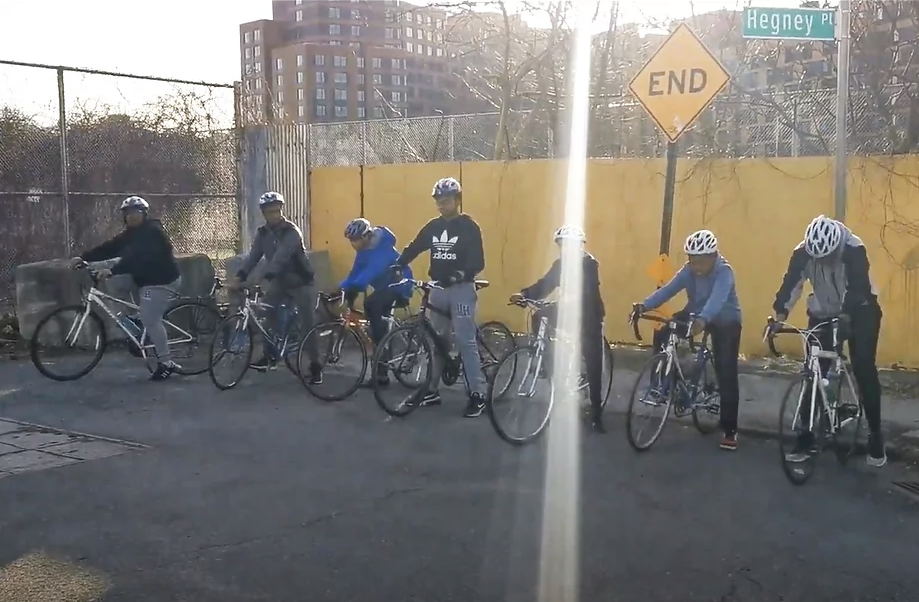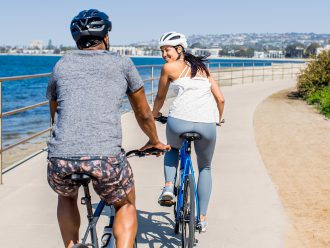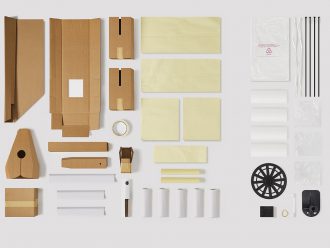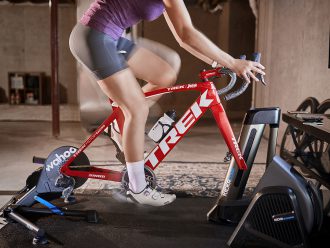- #GoByBike
- 14 October, 2020
Keep going by bike! Tips and tricks from Aliya Barnwell, president of Ride Up Grades, on how to ride through winter
Novice and dedicated cyclists alike embraced this summer’s bike boom, but now that it’s getting colder, going by bike can take on added challenges of low temperatures, rain, ice, and snow. Of course, that doesn’t mean quit and put the bike away. Commuting through the winter is easy and comfortable with the right gear. There are two major parts to riding through the winter temps: prepping the bike, and prepping you, the rider!
First, the rider: this can be tricky depending on an individual’s temperature tolerances, but proper clothing is key. Think in 10-degree increments: every 10 degrees, add (or remove) another layer or adjust clothing accordingly, and keep in mind that wind and precipitation shave off 5-10 degrees as well. For this reason, check the weather in the morning before a ride, and see how much of a temperature change is expected during a longer ride, or if inclement weather is headed toward the route.
In general steer toward wool, silk, or poly blends and away from cotton – cotton absorbs water and takes a long time to dry; if cotton gets sweaty or wet in cold weather, it can make the rider chilly, and being cold and wet is a recipe for discomfort in chilly weather and hypothermia in extreme cold.
Good pairs of gloves, socks, and shoes are key. Cold hands don’t grip bars or brakes as well as they should, so look for long fingered gloves for weather under 50 degrees Fahrenheit. Under 40, mittens or thicker gloves, or an over-glove are needed. Under that, if a rider is planning to be out longer than an hour, a pair of Barmitts is a good bet. Barmitts are large insulated neoprene and foam covers that fit over your handlebars and shifters, shielding the riders’ hands from the wind. Even better, during moderately cold temps, they make it easy to wear thinner, more flexible gloves.
For the feet, start with a good pair of thick socks. If the socks are not enough, add a layer between sock and shoe. Many a cyclist has used tin foil or a plastic bag. The purpose is to keep in body heat and create a shield from the wind. This is especially important for cyclists using clipless shoes. Clipless shoes generally have holes in the footbed to allow for cleat screw access: that means a place for the cold air – and worse, water — to creep in. If you’re wearing cycling shoes, you can also get a shoe cover that fits over the shoe, and on really cold days cyclists can add a layer of protection between the shoe cover and the shoe as well. For those planning on riding through the worst winter weather, wear boots – either cycling specific for cleats, or normal insulated hiking boots.
Riders will also want to protect their ears. Cold ears can turn into an immediate headache. A headband is a good start, a cap with a fold down ear flap is good too, down to freezing temps. After that, add a balaclava. This is also a good idea to protect a rider’s neck, depending on the jersey or jacket worn.
The jersey or jacket will depend on the weather. Unlined Goretex treated fabric is good with a long-sleeved base-layer, but thermal liners or poly sweatshirts hold the heat in very well. Whatever the choice, a wind-proof front panel and breathable or vented back panel make for a more comfortable ride by allowing body heat produced while riding to escape and simultaneously stopping the wind from cutting through a rider’s chest. A breathable back on any jacket is even more important when paired with a backpack.
If planning to ride through rain or snow, add waterproof or resistant outer layers: gloves, shoe covers or boots, and a jacket, preferably one with a hood that will fit under a helmet. Barring a hood, go for a high collar and a waterproof helmet cover. A cap comes in handy for precipitation as well – the brim keeps water out of the eyes. Have to see to ride safely!
In case of arriving at a destination sweaty, some riders bring a change of clothes or stash them ahead if possible, and put the dry set on upon arrival.
A bike is a bit easier to winterize because the requirements don’t vary by 10-degree temperature increments. Fenders, front and back, are a very good idea in winter. Even when a cyclist avoids riding in the rain or snow, if there is remaining precipitation on the roadway it will be kicked up onto the bike, and the rider. Barring full fenders, consider at least a clip-on mudguard to block the skunk streak (the streak of road dirt kicked up by the rear tire that sprays up a rider’s back, like the stripe on the back of a skunk). If riding through a ton of bad weather, consider a chain-guard as well.
Another thing to consider for the bike is wider, tougher tires. Wider, because they can be run at slightly lower pressure for improved traction. Tougher, because ice and snow tends to hide glass and other things that cause flats. A tire with some kind of puncture barrier is a welcome winter addition, especially on the rear tire which bears most of the rider’s weight.
It’s also even more important to carry lights in winter. Winter has less daylight hours, so riders are more likely to be caught by the dark. Lights aren’t just to see: they’re also to let other people, like drivers, see the rider.
And lastly a flat kit is a good thing to have on you year-round. That walk of shame to public transport or back to the house, and even that wait time for a Lyft is extra cold during the winter. Bring an emergency repair kit with a spare tube, tire levers, and a pump at the minimum, and maybe an extra link and chain-tool.
It is possible to have nice rides during winter, and feel a sense of accomplishment for going by bike, especially when other people react with shock that anyone would ride in weather that isn’t ideal. The bike is not just fun, it’s a means to an end – you can get to work or to the store, even if it’s cold. The bike and the gear are important, but not more important than the will to get out on the bike. Where there’s a will, there’s a way! Put on a jacket and some gloves and keep going!




